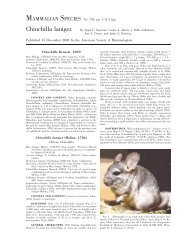Brugia Malayi - Clark Science Center - Smith College
Brugia Malayi - Clark Science Center - Smith College
Brugia Malayi - Clark Science Center - Smith College
You also want an ePaper? Increase the reach of your titles
YUMPU automatically turns print PDFs into web optimized ePapers that Google loves.
The Influence of MP3 Headphone on Human Ears<br />
Huimin Ji<br />
The popular usage of MP3 headphone potentially causing damage to ears has long been an issue. Especially when trying to drown<br />
out the outside noises, people turn up the volume of the headphone to high levels that in long term, could cause permanent<br />
damage to hearing. This project uses a system run by microcontroller, A-D converter and an SD memory storage card, which has<br />
been designed to record sound with a microphone and write the voltage response to the memory card, to collect, store and analyze<br />
the sound pressure output. This is a long-term project, and I focused on improving the prototype’s data collection speed and<br />
applying a microphone on a regular MP3 headphone for this summer.<br />
The prototype uses a Parallax microcontroller with Spin language as an algorithm. There is a protraction of time in writing the<br />
collected data into the SD card. For the prototype, it needs about 6s to write a series of 0.4s continuous data on the card. I focused<br />
on two parts to improve the writing speed: the SD card interface and the algorithm.<br />
There are three different logics for SD card application: SPI bus, 1-bit bus and 4-bit bus. The SPI bus mode is using two pins<br />
for data input and output respectively. The 1-bit bus mode is using one pin for both data input and output, and 4-bit bus mode<br />
is using four pins for both data input and output simultaneously. For current SD card interface, the fastest logic is the 4-bit bus<br />
mode, but the system of using this logic requires licensure so it is not applicable to this project. Using SPI bus mode for SD card,<br />
as in the prototype, is the optimized methods.<br />
To improve the writing speed by changing the code, I first revised it based on Spin language. The prototype uses a script<br />
package with one main file and a sub-file. The sub-file is applied to general memory cards’ reading and writing, so it starts by<br />
identifying the memory card type between SD, HCSD, and MMS card every time it runs, which takes up extra time. I cut off the<br />
redundant codes for the identification process, and limit the package to a high capacity SD (HCSD) card that is used in this project.<br />
Trimming the code did not make the writing speed fast enough, and the data collected within 0.4s can now be written into SD card<br />
in 3 seconds.<br />
Another optimizing method to accelerate the writing process is to convert parts of the script into Assembly language.<br />
Assembly language is a machine language, which runs a lot faster than Spin language. The converted part is in the main file of the<br />
SD card writing script package where the function is directly called in the integrated script. I have not finished this process yet, and<br />
it should be continued in the coming academic year research.<br />
Other than improving the prototype, I also applied a microphone to a regular MP3 headphone (as shown in photo above), in<br />
order to apply the developed prototype to MP3 music output measurements. (Supported by the Schultz Foundation)<br />
Advisor: Susan E. Voss<br />
2012<br />
105

















